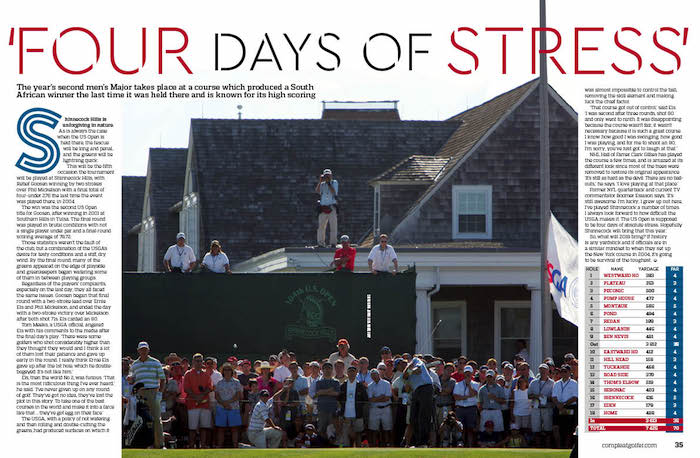The year’s second men’s Major takes place at a course which produced a South African winner the last time it was held there and is known for its high scoring.
Shinnecock Hills is unforgiving in nature. As is always the case when the US Open is held there, the fescue will be long and penal, and the greens will be lightning quick.
This will be the fifth occasion the tournament will be played at Shinnecock Hills, with Retief Goosen winning by two strokes over Phil Mickelson with a final total of four-under 276 the last time the event was played there, in 2004.
The win was the second US Open title for Goosen, after winning in 2001 at Southern Hills in Tulsa. The final round was played in brutal conditions with not a single player under par and a final-round scoring average of 78.72.
Those statistics weren’t the fault of the club, but a combination of the USGA’s desire for testy conditions and a stiff, dry wind. By the final round, many of the greens appeared on the edge of playableand greenkeepers began watering some of them in between playing groups.
Regardless of the players’ complaints, especially on the last day, they all faced the same issues. Goosen began that final round with a two-stroke lead over Ernie Els and Phil Mickelson, and ended the day with a two-stroke victory over Mickelson after both shot 71s. Els carded an 80.
Tom Meeks, a USGA official, angered Els with his comments to the media after the final day’s play. ‘There were some golfers who shot considerably higher than they thought they would and I think a lot of them lost their patience and gave up early in the round. I really think Ernie Els gave up after the 1st hole, which he double-bogeyed. It’s not like him.’
Els, then the world No 2, was furious. ‘That is the most ridiculous thing I’ve ever heard,’ he said. ‘I’ve never given up on any round of golf. They’ve got no idea, they’ve lost the plot in this story. To take one of the best courses in the world and make it into a farce like that … they’ve got egg on their face.’
The USGA, with a policy of not watering and then rolling and double-cutting the greens, had produced surfaces on which it was almost impossible to control the ball, removing the skill element and making luck the chief factor.
‘That course got out of control,’ said Els. ‘I was second after three rounds, shot 80 and only went to ninth. It was disappointing because the course wasn’t fair; it wasn’t necessary because it is such a great course. I know how good I was swinging, how good I was playing, and for me to shoot an 80, I’m sorry, you’ve just got to laugh at that.’
NHL Hall of Famer Clark Gillies has played the course a few times, and is amazed at its different look since most of the trees were removed to restore its original appearance. ‘It’s still as hard as the devil. There are no bail-outs,’ he says. ‘I love playing at that place.’
Former NFL quarterback and current TV commentator Boomer Esiason says, ‘It’s still awesome. I’m lucky, I grew up out here, I’ve played Shinnecock a number of times. I always look forward to how difficult the USGA makes it. The US Open is supposed to be four days of absolute stress. Hopefully Shinnecock will bring that this year.’
So, what will 2018 bring? If history is any yardstick and if officials are in a similar mindset to when they set up the New York course in 2004, it’s going to be survival of the toughest.
– This article first appeared in the June issue of Compleat Golfer








